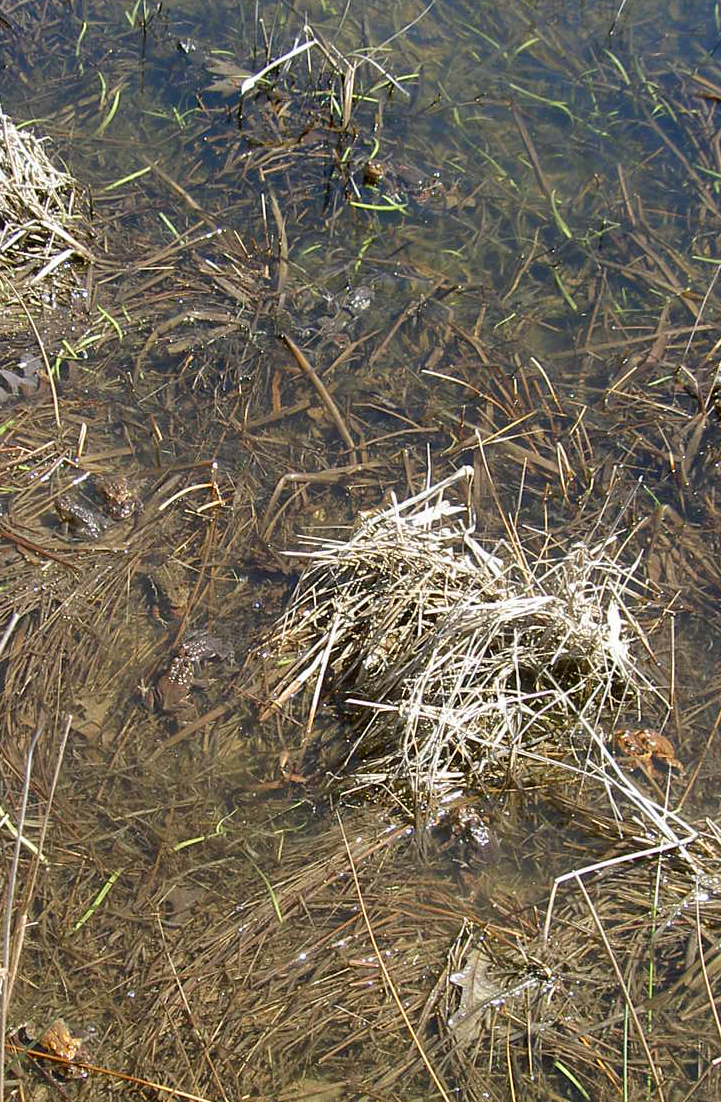Since getting the car last week I’ve taken two trips up to the Patuxent Wildlife Refuge to walk the trails and look for birds. Last Monday’s visit was on a rainy day, so I didn’t expect to see much. Not much is still something at a place like Patuxent, though, and the very first birds I spotted were a pair of Wood Ducks paddling around in the creek (the trickle of water that I expect will develop into a fuller marsh if we have a rainy summer). They didn’t appreciate my arrival and left with much hooting and flapping, startling a group of snipes up out of the reeds. The snipes were a new life bird for me, and seemed to have changed names between the publication of my older Peterson’s, where they’re listed as Common Snipes, and my newer Sibley’s, where they’re called Wilson’s Snipes. At any rate: I saw a bunch of snipes! Their distinctive back stripes made them easy to identify, and I was pleased to add another tricksy marsh bird to my list.
The walk through the woods was pleasant, but relatively bird-free. I saw some titmice and a heron wading around at the shoreline. Cash Lake Pier is the endpoint of the trail, and it was nice to sit and take in the view of the lake from up there. The Tree Swallows had returned and were swooping over the lake in large flocks. When I arrived at the pier I discovered a pair of Northern Rough-Winged Swallows just hanging out on the railing. I’d only seen them once before, last year at the University Hills pond, and it had been late enough in the season that I wasn’t entirely convinced they weren’t young Tree Swallows. It was nice to have a firm identification; second sightings are still exciting in my book! On Saturday my partner and I had stopped at Lake Artemesia and discovered a young Osprey hanging around. It also wasn’t a first sighting, but it was the first time I’d seen one close enough to be able to get a good look at the head and wing markings. Other sightings had been from the highway in a moving car, so this sighting marked a more firm identification.
I returned to Lake Artemesia on Tuesday, and was pleased to discover a small group of Pied-Billed Grebes swimming about. Unlike at Bombay Hook, there was no mistaking them this time, and I was thrilled to see them. There’s something about the small awkwardness of grebes that I find endearing. The Osprey was still hanging about, and while I didn’t get to see it dive, it did hover directly overhead a few times, which is always neat with such a large bird. I had assumed it was just passing through on its way to the shore and didn’t expect to see it again; now I’m wondering if it will stay and nest. There are also still groups of Ruddy Ducks and American Coots out on the lake, as well as at least one pair of Ring-Necked Ducks still hanging about.
Yesterday was another beautiful day after a stormy night, so I returned to Lake Artemesia to see if anything interesting had blown in. I wasn’t the only one to have this thought: I encountered two other people with binoculars at Lake Artemesia. The first was kind enough to let me know that Palm Warblers begin to travel through in the company of Yellow-Rumped Warblers this time of year, and the second alerted me to the presence of a Horned Grebe in breeding plumage on the Lake. I had seen the Horned Grebe in winter plumage hanging around, and did see it when I arrived, but I hadn’t noticed the other in among the Ruddy Ducks. This both confirmed my identification of the one in winter plumage—still nice for me with my level of experience—and allowed me to backtrack a bit and catch sight of the grebe with a splash of gold across its head. Since Horned Grebes are migratory, it’s rare to see them in breeding plumage this far south, and I’m thankful for the opportunity. Backtracking also led me to find a single Double-Crested Cormorant out on the water; I’d only previously seen them from afar on the ocean, so getting a good look at the cheek-markings was fun as well. The final gift of the morning was a male Eastern Towhee on the path near the parking lot; I’d seen my first female Eastern Towhee on the nearby Paint Branch trail about a month before. I’d sighted male towhees out west, but this was the first male of the eastern subspecies that I’d seen.
Following such a successful trip to Lake Artemesia, I couldn’t resist the urge to head up to Patuxent and see what had landed on the lake there. I am glad I did, as I had a great time! The first bird I saw was another new life bird, a Swamp Sparrow. I suspect I’ve seen these before, at Point Pelee and the University Hills pond, but this was the first time I was able to be absolutely sure. As I was standing watching the sparrow, I became aware of an overwhelming chorus of frogs. Amphibians are my first love, and so I following a footpath—likely a deer trail—through the grass to the edge of the creek. What to my wondering eyes did appear but a horde of toads emerging from their hibernation in the mud and chasing each other around in attempts to mate. One of my housemates in Ann Arbor witnessed this spring event years ago in a park near where we used to live, and I was so jealous. So jealous! Imagine the nicest material item you’ve ever wanted it being given to the most obnoxious person you’ve ever met, and then multiply that by about a thousand: that’s how jealous I was, not because my friend was obnoxious but because frogs and toads are my first love. At any rate, all that was washed away as I got to stand and watch all these toads acting kooky. As a visual aid, I offer you this photo of one small stretch of the creek (see how many toads you can find in it):

Toads mating at Patuxent.
Following that excitement, I was happy to just walk in the woods and enjoy myself whether or not I saw any birds. Near the trailhead I saw a pair of Eastern Bluebirds hanging about a nesting box; although I know they’re common out here, this was still only my fourth sighting and their bright coloring remains startling. In the woods I encountered an Eastern Phoebe, another bird that I’ve only seen a couple of times before; it was perched above the trail bobbing its tail and singing away. Along the shore there were turtles crowding every rock and log; like the toads, they were coming out of hibernation and seeking the sun. Up at the Cash Lake Pier I found both another Double-Crested Cormorant and a fellow birder—the binoculars give it away every time. I walked over to say hello and he was kind enough to point out a Common Loon out on the lake, another new life bird for me! As with bluebirds, loons had loomed large in my imagination, birds that were never sighted yet deeply loved and exotic to someone raised inland. He also pointed out the nesting platform that the circling Osprey seemed to be using; I look forward to returning through the summer and watching for young birds. As if those sightings weren’t all enough, I saw a Hermit Thrush in the woods on the walk back to the car, another bird that I’d sighted only once before—in the backyard of our most recent house in DC—and I was happy to get a second look.
Trips like these remind me of the positive side of being a relative novice at this birding stuff: I’m almost guaranteed to see something I’ve never seen before on each trip, as many common birds are still new. It also reminds me how lucky I am to have moved to an area with such diverse habitat, within reach of so many parks and refuges. It wasn’t something we took into consideration when choosing our house location, but being on the northeast side of the District in the Chesapeake Bay and Anacostia River watersheds has yielded one pleasant surprise after the other.

